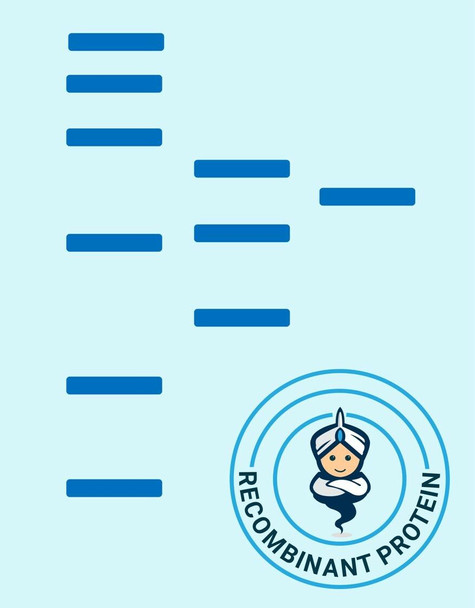Description
| Product Name: | Human CAT Recombinant Protein |
| Product Code: | RPPB1474 |
| Size: | 20µg |
| Species: | Human |
| Target: | CAT |
| Synonyms: | Catalase, CAT. |
| Source: | Escherichia Coli |
| Physical Appearance: | Sterile filtered yellowish solution. |
| Formulation: | The CAT solution (1mg/ml) contains 20mM Tris-HCl buffer (pH 8.0), 0.15M NaCl and 10% glycerol. |
| Stability: | Store at 4°C if entire vial will be used within 2-4 weeks. Store, frozen at -20°C for longer periods of time. For long term storage it is recommended to add a carrier protein (0.1% HSA or BSA).Avoid multiple freeze-thaw cycles. |
| Purity: | Greater than 90.0% as determined by SDS-PAGE. |
| Amino Acid Sequence: | MGSSHHHHHH SSGLVPRGSH MADSRDPASD QMQHWKEQRA AQKADVLTTG AGNPVGDKLN VITVGPRGPL LVQDVVFTDE MAHFDRERIP ERVVHAKGAG AFGYFEVTHD ITKYSKAKVF EHIGKKTPIA VRFSTVAGES GSADTVRDPR GFAVKFYTED GNWDLVGNNT PIFFIRDPIL FPSFIHSQKR NPQTHLKDPD MVWDFWSLRP ESLHQVSFLF SDRGIPDGHR HMNGYGSHTF KLVNANGEAV YCKFHYKTDQ GIKNLSVEDA ARLSQEDPDY GIRDLFNAIA TGKYPSWTFY IQVMTFNQAE TFPFNPFDLT KVWPHKDYPL IPVGKLVLNR NPVNYFAEVE QIAFDPSNMP PGIEASPDKM LQGRLFAYPD THRHRLGPNY LHIPVNCPYR ARVANYQRDG PMCMQDNQGG APNYYPNSFG APEQQPSALE HSIQYSGEVR RFNTANDDNV TQVRAFYVNV LNEEQRKRLC ENIAGHLKDA QIFIQKKAVK NFTEVHPDYG SHIQALLDKY NAEKPKNAIH TFVQSGSHLA AREKANL |
| Biological Activity: | Specific activity is >30,000 unit/mg. |
Catalase (CAT) is a key antioxidant enzyme in the body�s defense against oxidative stress. Furthermore, Catalase is a heme enzyme which is present in the peroxisome of virtually all aerobic cells. Catalase converts the reactive oxygen species hydrogen peroxide to water and oxygen and thus diminishes the toxic effects of hydrogen peroxide. Catalase stimulates growth of cells including T-cells, B-cells, myeloid leukemia cells, melanoma cells, mastocytoma cells and normal and transformed fibroblast cells. Catalase gene polymorphisms are linked with decreases in catalase activity nevertheless, to date, acatalasemia is the only disease known to be caused by the CAT gene.
CAT Human Recombinant produced in E.coli is a single, non-glycosylated polypeptide chain containing 547 amino acids (1-527) and having a molecular mass of 61.9kDa.CAT is fused to a 20 amino acid His-tag at N-terminus & purified by proprietary chromatographic techniques.
| UniProt Protein Function: | Catalase: Occurs in almost all aerobically respiring organisms and serves to protect cells from the toxic effects of hydrogen peroxide. Promotes growth of cells including T-cells, B-cells, myeloid leukemia cells, melanoma cells, mastocytoma cells and normal and transformed fibroblast cells. Homotetramer. Belongs to the catalase family. |
| UniProt Protein Details: | Protein type:Amino Acid Metabolism - tryptophan; Endoplasmic reticulum; EC 1.11.1.6; Apoptosis; Energy Metabolism - methane; Mitochondrial; Hydrolase; Oxidoreductase Chromosomal Location of Human Ortholog: 11p13 Cellular Component: peroxisomal membrane; Golgi apparatus; peroxisomal matrix; focal adhesion; intracellular membrane-bound organelle; membrane; endoplasmic reticulum; lysosome; plasma membrane; mitochondrial intermembrane space; peroxisome; cytosol Molecular Function:antioxidant activity; oxidoreductase activity, acting on peroxide as acceptor; enzyme binding; protein homodimerization activity; catalase activity; metal ion binding; heme binding; NADP binding; aminoacylase activity; receptor binding Biological Process: cholesterol metabolic process; hemoglobin metabolic process; nucleobase, nucleoside and nucleotide metabolic process; purine base metabolic process; activation of NF-kappaB transcription factor; protein homotetramerization; osteoblast differentiation; positive regulation of phosphoinositide 3-kinase cascade; response to vitamin E; response to reactive oxygen species; triacylglycerol metabolic process; response to hyperoxia; UV protection; hydrogen peroxide catabolic process; inhibition of NF-kappaB transcription factor; ureteric bud development; positive regulation of cell division; response to hypoxia; aerobic respiration; purine nucleotide catabolic process; protein tetramerization; negative regulation of apoptosis; aging Disease: Acatalasemia |
| NCBI Summary: | This gene encodes catalase, a key antioxidant enzyme in the bodies defense against oxidative stress. Catalase is a heme enzyme that is present in the peroxisome of nearly all aerobic cells. Catalase converts the reactive oxygen species hydrogen peroxide to water and oxygen and thereby mitigates the toxic effects of hydrogen peroxide. Oxidative stress is hypothesized to play a role in the development of many chronic or late-onset diseases such as diabetes, asthma, Alzheimer's disease, systemic lupus erythematosus, rheumatoid arthritis, and cancers. Polymorphisms in this gene have been associated with decreases in catalase activity but, to date, acatalasemia is the only disease known to be caused by this gene. [provided by RefSeq, Oct 2009] |
| UniProt Code: | P04040 |
| NCBI GenInfo Identifier: | 115702 |
| NCBI Gene ID: | 847 |
| NCBI Accession: | P04040.3 |
| UniProt Related Accession: | P04040 |
| Molecular Weight: | |
| NCBI Full Name: | Catalase |
| NCBI Synonym Full Names: | catalase |
| NCBI Official Symbol: | CAT�� |
| NCBI Protein Information: | catalase |
| UniProt Protein Name: | Catalase |
| Protein Family: | Catalase |
| UniProt Gene Name: | CAT�� |
| UniProt Entry Name: | CATA_HUMAN |








